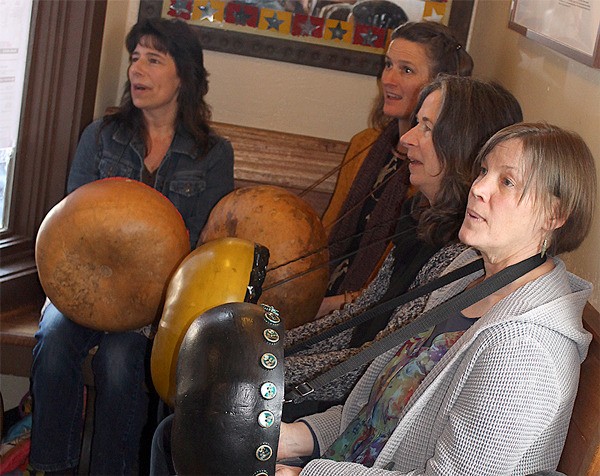In Shona, one of 16 official Zimbabwean languages, the word Sarungano means storyteller.
The women of Sarungano are known throughout South Whidbey for sharing the story of traditional Zimbabwean music through their rich rhythms and joyous melodies, most of which are performed on mbiras.
In April, the foursome will be acting as “ambassadors of the community” by taking the music back to its heartland.
 Musicians Dana Moffett, Leslie Breeden, Donita Crosby and Dyanne Harshman are working to raise funds in order to provide traditional instruments like mbiras to Zimbabwean children, most of whom do not have access to them despite their historical origins and cultural significance.
Musicians Dana Moffett, Leslie Breeden, Donita Crosby and Dyanne Harshman are working to raise funds in order to provide traditional instruments like mbiras to Zimbabwean children, most of whom do not have access to them despite their historical origins and cultural significance.
Mbiras are African musical instruments known to some as “thumb pianos.” They consist of a wooden board with attached metal tines, staggered to produce different notes. The mbira is placed within a wooden resonator which amplifies the sound.
It is most popular in the Democratic Republic of Congo and amongst the Shona of Zimbabwe and is often played at sacred ceremonies while a similar instrument, the nyunga nyunga, is more often used for performance.
All of Sarungano’s songs are in Shona, which the women sing with ease.
Instruments like the mbira were banned in many Zimbabwean schools in tandem with the onset of European colonization. Authorities deemed traditional music to be reflective of non-Christian spiritual beliefs.
During the 1950s and 1960s, musicians and activists began making attempts to get traditional music back into the schools. This work is continuing today through organizations like MBIRA and groups like Sarungano.
Most schools in modern Zimbabwe are unable to afford to purchase instruments and many do not provide a music program.
The members of Sarungano, along with a number of friends and community members on Whidbey and in Africa, are determined to bring the mbira and similarly quintessential Zimbabwean instruments back into children’s lives.
It is a natural progression for the group of musicians, who are also avid teachers and students of African music.
Moffett has been teaching mbira, marimba and nyunga nyunga on Whidbey since 2003, when she opened her school and studio by the name of Rubatano paChitsuwa, which means “united on the island.”
At Rubatano, Moffett hosts numerous Zimbabwean visitors, friends and fellow instructors. She, along with her bandmates, have established strong relationships with friends and fellow mbira, marimba and nyunga nyunga players overseas who are supportive of their work.
“They’ve been given the message to spread the music over the world,” Moffett said of Zimbabwean traditional musicians.
Students of Rubatano paChitsuwa will be joining Sarungano during their third fundraiser Marimba Cafe at 6:30 p.m. Saturday, March 28, at Whidbey Island Center for the Arts in Langley.
Proceeds from the event will go towards the purchase of mbiras which the women will deliver to children on their upcoming trip to Zimbabwe on April 17. They plan to purchase the instruments from local craftsmen once they have arrived.
The suggested donation for admission to Marimba Cafe is between $5-10, though larger donations are welcome.
Moffett emphasized that it is not only Sarungano, but the students of Rubatano paChitsuwa and numerous fellow music lovers, friends and community members who are assisting in this project.
This will be the first time visiting Zimbabwe for Breeden and Harshman, though Moffett made her first trip in 2005 and her second in 2008. Crosby accompanied Moffett in 2008.
The songs of Zimbabwe are reflective of the attitude of its people, according to Moffett and Crosby.
The country was in turmoil in 2008, with violent political unrest and an outbreak of cholera.
“There was heartbreak everywhere,” Moffett recalled. She noted that despite the immense hardships faced by the majority of the populace, people managed to find joy. She said that it is one of the defining characteristics of Zimbabwean culture, one which carries into its music.
Harshman explained that several of the cheery-sounding songs contain lyrics addressing deeply somber subjects such as the death of a loved one.
“That’s a cultural riddle,” she said.
The music, too, is a bit of a riddle for musicians trained in Western musical styles, according to Harshman. It’s a challenge she relishes, as she said it forces her to think differently as an artist.
“There’s the feeling in the music of a feather being lifted and never quite falling,” Harshman said.
“It’s not music you do alone,” she added. “It’s not complete if you’re doing it alone.”


